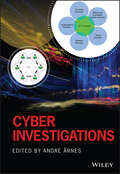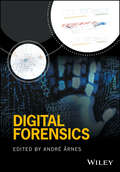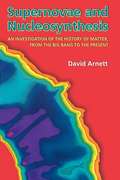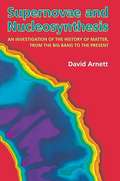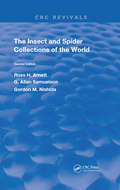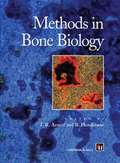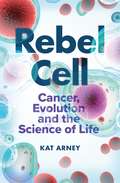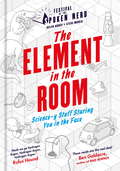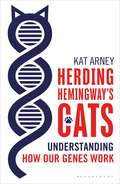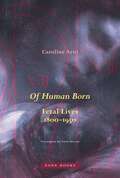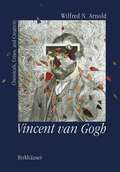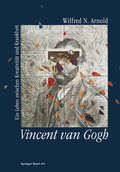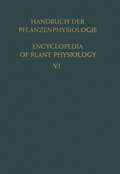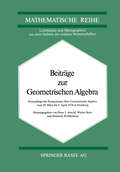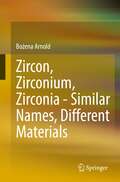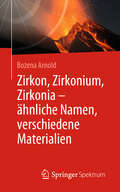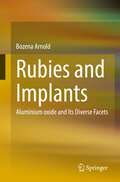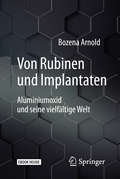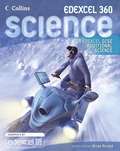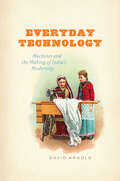- Table View
- List View
Cyber Investigations
by André ÅrnesCYBER INVESTIGATIONS A classroom tested introduction to cyber investigations with real-life examples included Cyber Investigations provides an introduction to the topic, an overview of the investigation process applied to cyber investigations, a review of legal aspects of cyber investigations, a review of Internet forensics and open-source intelligence, a research-based chapter on anonymization, and a deep-dive in to multimedia forensics. The content is structured in a consistent manner, with an emphasis on accessibility for students of computer science, information security, law enforcement, and military disciplines. To aid in reader comprehension and seamless assimilation of the material, real-life examples and student exercises are provided throughout, as well as an Educational Guide for both teachers and students. The material has been classroom-tested and is a perfect fit for most learning environments. Written by a highly experienced author team with backgrounds in law enforcement, academic research, and industry, sample topics covered in Cyber Investigations include: The cyber investigation process, including developing an integrated framework for cyber investigations and principles for the integrated cyber investigation process (ICIP) Cyber investigation law, including reasonable grounds to open a criminal cyber investigation and general conditions for privacy-invasive cyber investigation methods Perspectives of internet and cryptocurrency investigations, including examples like the proxy seller, the scammer, and the disgruntled employee Internet of things (IoT) investigations, including types of events leading to IoT investigations and new forensic challenges in the field Multimedia forensics facilitates the understanding of the role of multimedia in investigations, including how to leverage similarity matching, content-based tracing, and media metadata. Anonymization networks discusses how such networks work, and how they impact investigations? It addresses aspects of tracing, monitoring, evidence acquisition, de-anonymization, and large investigations Based on research, teaching material, experiences, and student feedback over several years, Cyber Investigations is ideal for all students and professionals in the cybersecurity industry, providing comprehensive subject coverage from faculty, associates, and former students of cyber security and digital forensics at the Norwegian University of Science and Technology (NTNU).
Digital Forensics
by André ÅrnesThe definitive text for students of digital forensics, as well as professionals looking to deepen their understanding of an increasingly critical field Written by faculty members and associates of the world-renowned Norwegian Information Security Laboratory (NisLab) at the Norwegian University of Science and Technology (NTNU), this textbook takes a scientific approach to digital forensics ideally suited for university courses in digital forensics and information security. Each chapter was written by an accomplished expert in his or her field, many of them with extensive experience in law enforcement and industry. The author team comprises experts in digital forensics, cybercrime law, information security and related areas. Digital forensics is a key competency in meeting the growing risks of cybercrime, as well as for criminal investigation generally. Considering the astonishing pace at which new information technology – and new ways of exploiting information technology – is brought on line, researchers and practitioners regularly face new technical challenges, forcing them to continuously upgrade their investigatory skills. Designed to prepare the next generation to rise to those challenges, the material contained in Digital Forensics has been tested and refined by use in both graduate and undergraduate programs and subjected to formal evaluations for more than ten years. Encompasses all aspects of the field, including methodological, scientific, technical and legal matters Based on the latest research, it provides novel insights for students, including an informed look at the future of digital forensics Includes test questions from actual exam sets, multiple choice questions suitable for online use and numerous visuals, illustrations and case example images Features real-word examples and scenarios, including court cases and technical problems, as well as a rich library of academic references and references to online media Digital Forensics is an excellent introductory text for programs in computer science and computer engineering and for master degree programs in military and police education. It is also a valuable reference for legal practitioners, police officers, investigators, and forensic practitioners seeking to gain a deeper understanding of digital forensics and cybercrime.
Supernovae and Nucleosynthesis: An Investigation of the History of Matter, from the Big Bang to the Present
by David ArnettThis book investigates the question of how matter has evolved since its origin in the Big Bang, from the cosmological synthesis of hydrogen and helium to the generation of the complex set of nuclei that comprise our world and our selves. A central theme is the evolution of gravitationally contained thermonuclear reactors, otherwise known as stars. Our current understanding is presented systematically and quantitatively, by combining simple analytic models with new state-of-the-art computer simulations. The narrative begins with the clues (primarily the solar system abundance pattern), the constraining physics (primarily nuclear and particle physics), and the thermonuclear burning in the Big Bang itself. It continues with a step-by-step description of how stars evolve by nuclear reactions, a critical investigation of supernova explosion mechanisms and the formation of neutron stars and of black holes, and an analysis of how such explosions appear to astronomers (illustrated by comparison with recent observations). It concludes with a synthesis of these ideas for galactic evolution, with implications for nucleosynthesis in the first generation of stars and for the solar system abundance pattern. Emphasis is given to questions that remain open, and to active research areas that bridge the disciplines of astronomy, cosmochemistry, physics, and planetary and space science. Extensive references are given.
Supernovae and Nucleosynthesis: An Investigation of the History of Matter, from the Big Bang to the Present (Princeton Series in Astrophysics #55)
by David ArnettThis book investigates the question of how matter has evolved since its origin in the Big Bang, from the cosmological synthesis of hydrogen and helium to the generation of the complex set of nuclei that comprise our world and our selves. A central theme is the evolution of gravitationally contained thermonuclear reactors, otherwise known as stars. Our current understanding is presented systematically and quantitatively, by combining simple analytic models with new state-of-the-art computer simulations. The narrative begins with the clues (primarily the solar system abundance pattern), the constraining physics (primarily nuclear and particle physics), and the thermonuclear burning in the Big Bang itself. It continues with a step-by-step description of how stars evolve by nuclear reactions, a critical investigation of supernova explosion mechanisms and the formation of neutron stars and of black holes, and an analysis of how such explosions appear to astronomers (illustrated by comparison with recent observations). It concludes with a synthesis of these ideas for galactic evolution, with implications for nucleosynthesis in the first generation of stars and for the solar system abundance pattern. Emphasis is given to questions that remain open, and to active research areas that bridge the disciplines of astronomy, cosmochemistry, physics, and planetary and space science. Extensive references are given.
The Insect & Spider Collections of the World (CRC Press Revivals)
by Ross H. Arnett, Jr. G. Allan Samuelson Gordon M. NishidaFirst published in 1993, completely rewritten, this second edition includes a list of all 210 countries of the world and all of the islands, with comments on the existence of insect and spider collections, both public and private. These listings are arranged alphabetically by country, state/province, and city, with private collections listed under the public collection with which they are registered. Part II of the directory is an alphabetical list of the codes assigned to each of the collections described in Part I. This list is also cross-referenced to variations of the codes used in other works, which will eliminate any confusion over this duplication. This classic work provides a ready reference to all collections and is required by all insect and spider systematists.
The Insect & Spider Collections of the World (CRC Press Revivals)
by Ross H. Arnett, Jr. G. Allan Samuelson Gordon M. NishidaFirst published in 1993, completely rewritten, this second edition includes a list of all 210 countries of the world and all of the islands, with comments on the existence of insect and spider collections, both public and private. These listings are arranged alphabetically by country, state/province, and city, with private collections listed under the public collection with which they are registered. Part II of the directory is an alphabetical list of the codes assigned to each of the collections described in Part I. This list is also cross-referenced to variations of the codes used in other works, which will eliminate any confusion over this duplication. This classic work provides a ready reference to all collections and is required by all insect and spider systematists.
Methods in Bone Biology
by Timothy R. Arnett Brian HendersonMethods in Bone Biology is unique in being devoted to describing the methodology used by bone researchers. This book describes in detail the techniques of cell and organ culture used in the study of bone and bone cell function and the techniques used to monitor the skeleton and skeletal remodelling both in clinical and experimental settings.
Rebel Cell: Cancer, Evolution and the Science of Life
by Dr Kat Arney'This book is packed with big ideas about life. Every chapter has something in it which made me think wow. Having worked in a major cancer charity for many years, Arney writes with genuine in-depth understanding and is a perfect guide.' Daniel M. Davis, author of The Beautiful Cure'Rebel Cell is a bright, engaging read, fizzing with energy and metaphor. Kat Arney is a science writer for all of us - a powerful and talented story teller.' Stephen McGann'Kat's book is Dynamite. A crystal clear reappraisal of the story behind that word we fear to mention.' Dallas Campbell, author of Ad Astra: An Illustrated Guide to Leaving the PlanetCancer has always been with us. It killed our hominid ancestors, the mammals they evolved from and the dinosaurs that trampled the ground before that. Tumours grow in pets, livestock and wild animals. Even tiny jelly-like Hydra - creatures that are little more than a tube full of water - can get cancer. Paradoxically, many of us think of cancer as a contemporary killer, a disease of our own making caused by our modern lifestyles. But that's not true. Although it might be rare in many species, cancer is the enemy lurking within almost every living creature. Why? Because cancer is a bug in the system of life. We get cancer because we can't not get it.Cancer starts when cells revolt, throwing off their molecular shackles, and growing and dividing out of control in a shambolic mockery of normal life. This is why we can't avoid cancer: because the very genes that drive it are essential for life itself. The revolution has raged, on and off, for millions of years. But it was only in the twentieth century that doctors and scientists made any significant progress in understanding and treating cancer, and it's only in the past few decades that we've finally begun to kick the mob's malignant arse. Now the game is changing. Scientists have infiltrated cancer's cellular rebellion and are finally learning its secrets.Geneticist and science writer Kat Arney takes the reader back to the dawn of life on planet earth right up to the present day to get to the heart of what cancer really is and how by better understanding it we might one day overcome it.
The Element in the Room: Science-y Stuff Staring You in the Face
by Helen Arney Steve Mould'Made me go Hydrogen Argon, Hydrogen Argon, Hydrogen Argon.' Rufus HoundAs featured in Best stocking-filler books of 2017 - The Guardian'Witty and clever writing, every topic is engaging, fun and in some cases laugh-out-loud funny...there are too many highlights to mention' - How it Works Why is it impossible to spin your right foot clockwise while you draw a 6 with your right hand? Can you extract DNA from a strawberry daiquiri? Would you make love like a praying mantis? Should you book a holiday on Earth 2.0? The Element in the Room will take you on a rib-tickling, experiment-fuelled adventure to explain everyday science that is staring you in the face. If you are sci-curious, pi-curious or just the-end-is-nigh-curious then this is the book for you.Steve Mould and Helen Arney are two thirds of science comedy phenomenon Festival of the Spoken Nerd. As a trio they have appeared on QI, created their own experimental* comedy show 'Domestic Science' for Radio 4, toured their stand-up science shows to over 50,000 nerds (and non-nerds) and accumulated millions of views on YouTube.'These nerds are the real deal' - Ben Goldacre, author of BAD SCIENCE 'They make science fun and understandable which is a great combo.' Sandi Toksvig'MIND BLOWN.' Tim Harford'Science was never such hilarious explosive fun.' Richard Herring'This book is 37% better than mine. But it took 100% more nerds to write it.' Matt Parker (the other third of Spoken Nerd)
Herding Hemingway's Cats: Understanding how our genes work
by Kat ArneyThe language of genes has become common parlance. We know they make your eyes blue, your hair curly or your nose straight. The media tells us that our genes control the risk of cancer, heart disease, alcoholism or Alzheimer's. The cost of DNA sequencing has plummeted from billions of pounds to a few hundred, and gene-based advances in medicine hold huge promise.So we've all heard of genes, but how do they actually work?There are 2.2 metres of DNA inside every one of your cells, encoding roughly 20,000 genes. These are the 'recipes' that tell our cells how to make the building blocks of life, along with myriad control switches ensuring they're turned on and off at the right time and in the right place. But rather than a static string of genetic code, this is a dynamic, writhing biological library. Figuring out how it all works – how your genes build your body – is a major challenge for researchers around the world. And what they're discovering is that far from genes being a fixed, deterministic blueprint, things are much more random and wobbly than anyone expected.Drawing on stories ranging from six toed cats and stickleback hips to Mickey Mouse mice and zombie genes – told by researchers working at the cutting edge of genetics – Kat Arney explores the mysteries in our genomes with clarity, flair and wit, creating a companion reader to the book of life itself.
Of Human Born: Fetal Lives, 1800–1950
by Caroline ArniA new history of the concept of fetal life in the human sciencesAt a time when the becoming of a human being in a woman&’s body has, once again, become a fraught issue—from abortion debates and surrogacy controversies to prenatal diagnoses and assessments of fetal risk—Of Human Born presents the largely unknown history of how the human sciences came to imagine the unborn in terms of &“life before birth.&”Caroline Arni shows how these sciences created the concept of &“fetal life&” by way of experimenting on animals, pregnant women, and newborns; how they worried about the influence of the expectant mother&’s living conditions; and how they lingered on the question of the beginnings of human subjectivity. Such were the concerns of physiologists, pediatricians, psychologists, and psychoanalysts as they advanced the novel discipline of embryology while, at the same time, grappling with age-old questions about the coming-into-being of a human person. Of Human Born thus draws attention to the fundamental way in which modern approaches to the unborn have been intertwined with the configuration of &“the human&” in the age of scientific empiricism.Arni revises the narrative that the &“modern embryo&” is quintessentially an embryo disembedded from the pregnant woman&’s body. On the contrary, she argues that the concept of fetal life cannot be separated from its dependency on the maternal organism, countering the rhetorical discourses that have fueled the recent rollback of abortion rights in the United States.
Of Human Born: Fetal Lives, 1800–1950
by Caroline ArniA new history of the concept of fetal life in the human sciencesAt a time when the becoming of a human being in a woman&’s body has, once again, become a fraught issue—from abortion debates and surrogacy controversies to prenatal diagnoses and assessments of fetal risk—Of Human Born presents the largely unknown history of how the human sciences came to imagine the unborn in terms of &“life before birth.&”Caroline Arni shows how these sciences created the concept of &“fetal life&” by way of experimenting on animals, pregnant women, and newborns; how they worried about the influence of the expectant mother&’s living conditions; and how they lingered on the question of the beginnings of human subjectivity. Such were the concerns of physiologists, pediatricians, psychologists, and psychoanalysts as they advanced the novel discipline of embryology while, at the same time, grappling with age-old questions about the coming-into-being of a human person. Of Human Born thus draws attention to the fundamental way in which modern approaches to the unborn have been intertwined with the configuration of &“the human&” in the age of scientific empiricism.Arni revises the narrative that the &“modern embryo&” is quintessentially an embryo disembedded from the pregnant woman&’s body. On the contrary, she argues that the concept of fetal life cannot be separated from its dependency on the maternal organism, countering the rhetorical discourses that have fueled the recent rollback of abortion rights in the United States.
Vincent van Gogh: Chemicals, Crises and Creativity
by ARNOLDAs a five year old I encountered a picture of a young man in a rakish hat and a yellow coat, on the wall of a large classroom. There was something instantly intriguing about the image, but it was also puzzling because it represented neither politician nor prince, the usual fare for Australian school decorations. I was eventually told that this was a reproduction of a painting, the artist was Vincent van Gogh, and that the subject was some young Frenchman. On special days we assembled in that room and during the next several years I found myself gazing beyond visiting speakers at the fellow in the yellow jacket. It was almost another fifty years before I felt properly conversant with the portrait and realized that van Gogh's subject, Armand Roulin, was seventeen at the time ofthe original painting and had died at seventy-four during my schoolboy contemplations. In the interim my enjoyment of the works of the Impressionists and Post Impressionists had grown and I occasionally ran into the name of Dr. Gachet, Vincent's last attending physician, in books and catalog essays. The doctor was my entree to the overlapping charms of medical and art histories. In 1987 I had the good fortune to participate as a biochemist in the centenary celebration of the Pasteur Institut in Paris.
Aufbau · Speicherung · Mobilisierung und Umbildung der Kohlenhydrate / Formation · Storage · Mobilization and Transformation of Carbohydrates (Handbuch der Pflanzenphysiologie Encyclopedia of Plant Physiology #6)
by A. ArnoldBeiträge zur Geometrischen Algebra: Proceedings des Symposiums über Geometrische Algebra vom 29 März bis 3. April 1976 in Duisburg (Lehrbücher und Monographien aus dem Gebiete der exakten Wissenschaften #21)
by Arnold Benz WefelscheidZircon, Zirconium, Zirconia - Similar Names, Different Materials
by Bożena ArnoldIn this book you will find a lot of exciting and often astonishing information about these extraordinary and diverse materials. The presentation is essentially structured chronologically and follows the history of the discovery of these materials. Their properties and areas of application are described. The book is a mixture of specialist and non-fiction: understandable for experts and laypeople.This book is a translation of the original German 1st edition Zirkon, Zirkonium, Zirkonia - ähnliche Namen, verschiedene Materialien by Bożena Arnold, published by Springer-Verlag GmbH Germany, part of Springer Nature in 2019. The translation was done with the help of artificial intelligence (machine translation by the service DeepL.com). A subsequent human revision was done primarily in terms of content, so that the book will read stylistically differently from a conventional translation. Springer Nature works continuously to further the development of tools for the production of books and on the related technologies to support the authors.
Zirkon, Zirkonium, Zirkonia - ähnliche Namen, verschiedene Materialien
by Bożena ArnoldIm vorliegenden Buch finden Sie viele spannende und oft erstaunliche Informationen über diese außergewöhnlichen und vielfältigen Materialien. Die Darstellung ist im Wesentlichen chronologisch aufgebaut und folgt der Geschichte der Entdeckung dieser Materialien. Dabei werden ihre Eigenschaften und Anwendungsbereiche beschrieben. Das Buch stellt eine Mischung aus Fach- und Sachbuch dar: verständlich für Fachleute und Laien.
Rubies and Implants: Aluminium oxide and Its Diverse Facets
by Bozena ArnoldA material that enchants us as ruby or sapphire and is applied in watches or lasers.A material that gives us a better life in the form of implants.A material that provides irreplaceable technical services with its hardness and heat resistance.A fascinating material. Its name is aluminium oxide.In this book you will find a lot of exciting and often astonishing information about this extraordinary material. First, the necessary facts about the substance aluminium oxide are given. Then the world of the gemstones ruby and sapphire is described. And finally, the world of alumina as well as technical ceramics is illuminated.
Von Rubinen und Implantaten: Aluminiumoxid und seine vielfältige Welt (Technik im Fokus)
by Bozena ArnoldEin Material, das uns als Rubin oder Saphir verzaubert und in Uhren oder Lasern angewendet wird. Ein Material, das uns in Form von Implantaten ein besseres Leben ermöglicht. Ein Material, das mit seiner Härte und Wärmebeständigkeit unersetzliche technische Dienste leistet. Ein faszinierendes Material. Sein Name ist Aluminiumoxid. Im vorliegenden Buch finden Sie viele spannende und oft erstaunliche Informationen über dieses außergewöhnliche Material. Zuerst werden die notwendigen Fakten über den Stoff Aluminiumoxid genannt. Danach wird die Welt der Edelsteine Rubin und Saphir beschrieben. Und schließlich wird die Welt der Tonerde sowie der technischen Keramik beleuchtet.
GCSE Science for Edexcel — ADDITIONAL SCIENCE STUDENT BOOK (PDF)
by Brian ArnoldPart of Collins' Edexcel GCSE Sciences series, this student textbook has been written in consultation with Edexcel. The student textbook offers highly stimulating material, packed with real-world science and fully differentiated to engage and cater for all students.
Everyday Technology: Machines and the Making of India's Modernity (science.culture)
by David ArnoldIn 1909 Mohandas Karamchand Gandhi, on his way back to South Africa from London, wrote his now celebrated tract Hind Swaraj, laying out his vision for the future of India and famously rejecting the technological innovations of Western civilization. Despite his protestations, Western technology endured and helped to make India one of the leading economies in our globalized world. Few would question the dominant role that technology plays in modern life, but to fully understand how India first advanced into technological modernity, argues David Arnold, we must consider the technology of the everyday. Everyday Technology is a pioneering account of how small machines and consumer goods that originated in Europe and North America became objects of everyday use in India in the late nineteenth and early twentieth centuries. Rather than investigate “big” technologies such as railways and irrigation projects, Arnold examines the assimilation and appropriation of bicycles, rice mills, sewing machines, and typewriters in India, and follows their impact on the ways in which people worked and traveled, the clothes they wore, and the kind of food they ate. But the effects of these machines were not limited to the daily rituals of Indian society, and Arnold demonstrates how such small-scale technologies became integral to new ways of thinking about class, race, and gender, as well as about the politics of colonial rule and Indian nationhood. Arnold’s fascinating book offers new perspectives on the globalization of modern technologies and shows us that to truly understand what modernity became, we need to look at the everyday experiences of people in all walks of life, taking stock of how they repurposed small technologies to reinvent their world and themselves.
Everyday Technology: Machines and the Making of India's Modernity (science.culture)
by David ArnoldIn 1909 Mohandas Karamchand Gandhi, on his way back to South Africa from London, wrote his now celebrated tract Hind Swaraj, laying out his vision for the future of India and famously rejecting the technological innovations of Western civilization. Despite his protestations, Western technology endured and helped to make India one of the leading economies in our globalized world. Few would question the dominant role that technology plays in modern life, but to fully understand how India first advanced into technological modernity, argues David Arnold, we must consider the technology of the everyday. Everyday Technology is a pioneering account of how small machines and consumer goods that originated in Europe and North America became objects of everyday use in India in the late nineteenth and early twentieth centuries. Rather than investigate “big” technologies such as railways and irrigation projects, Arnold examines the assimilation and appropriation of bicycles, rice mills, sewing machines, and typewriters in India, and follows their impact on the ways in which people worked and traveled, the clothes they wore, and the kind of food they ate. But the effects of these machines were not limited to the daily rituals of Indian society, and Arnold demonstrates how such small-scale technologies became integral to new ways of thinking about class, race, and gender, as well as about the politics of colonial rule and Indian nationhood. Arnold’s fascinating book offers new perspectives on the globalization of modern technologies and shows us that to truly understand what modernity became, we need to look at the everyday experiences of people in all walks of life, taking stock of how they repurposed small technologies to reinvent their world and themselves.
Everyday Technology: Machines and the Making of India's Modernity (science.culture)
by David ArnoldIn 1909 Mohandas Karamchand Gandhi, on his way back to South Africa from London, wrote his now celebrated tract Hind Swaraj, laying out his vision for the future of India and famously rejecting the technological innovations of Western civilization. Despite his protestations, Western technology endured and helped to make India one of the leading economies in our globalized world. Few would question the dominant role that technology plays in modern life, but to fully understand how India first advanced into technological modernity, argues David Arnold, we must consider the technology of the everyday. Everyday Technology is a pioneering account of how small machines and consumer goods that originated in Europe and North America became objects of everyday use in India in the late nineteenth and early twentieth centuries. Rather than investigate “big” technologies such as railways and irrigation projects, Arnold examines the assimilation and appropriation of bicycles, rice mills, sewing machines, and typewriters in India, and follows their impact on the ways in which people worked and traveled, the clothes they wore, and the kind of food they ate. But the effects of these machines were not limited to the daily rituals of Indian society, and Arnold demonstrates how such small-scale technologies became integral to new ways of thinking about class, race, and gender, as well as about the politics of colonial rule and Indian nationhood. Arnold’s fascinating book offers new perspectives on the globalization of modern technologies and shows us that to truly understand what modernity became, we need to look at the everyday experiences of people in all walks of life, taking stock of how they repurposed small technologies to reinvent their world and themselves.
Everyday Technology: Machines and the Making of India's Modernity (science.culture)
by David ArnoldIn 1909 Mohandas Karamchand Gandhi, on his way back to South Africa from London, wrote his now celebrated tract Hind Swaraj, laying out his vision for the future of India and famously rejecting the technological innovations of Western civilization. Despite his protestations, Western technology endured and helped to make India one of the leading economies in our globalized world. Few would question the dominant role that technology plays in modern life, but to fully understand how India first advanced into technological modernity, argues David Arnold, we must consider the technology of the everyday. Everyday Technology is a pioneering account of how small machines and consumer goods that originated in Europe and North America became objects of everyday use in India in the late nineteenth and early twentieth centuries. Rather than investigate “big” technologies such as railways and irrigation projects, Arnold examines the assimilation and appropriation of bicycles, rice mills, sewing machines, and typewriters in India, and follows their impact on the ways in which people worked and traveled, the clothes they wore, and the kind of food they ate. But the effects of these machines were not limited to the daily rituals of Indian society, and Arnold demonstrates how such small-scale technologies became integral to new ways of thinking about class, race, and gender, as well as about the politics of colonial rule and Indian nationhood. Arnold’s fascinating book offers new perspectives on the globalization of modern technologies and shows us that to truly understand what modernity became, we need to look at the everyday experiences of people in all walks of life, taking stock of how they repurposed small technologies to reinvent their world and themselves.
